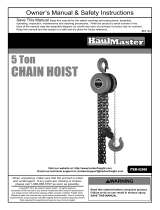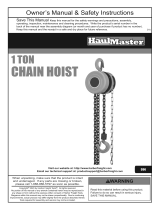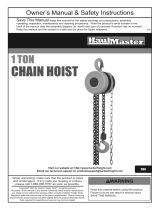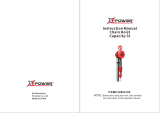
!"#"$%&'(%)*+#"$*%,$-%.$$/-00)))1.,(+&(2(*"3.$14&5
65,"7%&'(%$*4.8"4,7%#'//&($%,$-%/(&9'4$#'//&($:.,(+&(2(*"3.$14&5
Owner’s Manual & Safety Instructions
Save This Manual Keep this manual for the safety warnings and precautions, assembly,
operating, inspection, maintenance and cleaning procedures. Write the product’s serial number in the
back of the manual near the assembly diagram (or month and year of purchase if product has no number).
Keep this manual and the receipt in a safe and dry place for future reference. 20l
When unpacking, make sure that the product is intact
and undamaged. If any parts are missing or broken,
please call 1-888-866-5797 as soon as possible.
Copyright
©
2020 by Harbor Freight Tools
®
. All rights reserved.
No portion of this manual or any artwork contained herein may be reproduced in
any shape or form without the express written consent of Harbor Freight Tools.
Diagrams within this manual may not be drawn proportionally. Due to continuing
improvements, actual product may differ slightly from the product described herein.
Tools required for assembly an d se rv ic e may n ot b e in cl uded.
Read this material before using this product.
Failure to do so can result in serious injury.
SAVE THIS MANUAL.

Page 2 ;&(%$*4.8"4,7%<'*#$"&8#=%/7*,#*%4,77%>?@@@?@AA?BCDC1 Item 62969
EF;6GH IJ6KFGLIM LMEJ6NGLIMLMEGFOOFGLIM
G,+7*%&2%N&8$*8$#
Safety ......................................................... 3
Specifications ............................................. 5
Installation .................................................. 5
Operation .................................................... 6
Inspection ................................................... 8
Parts List and Diagram .............................. 10
Warranty .................................................... 12
PFKMLMQ%EHRSIOE%FMT%T6;LMLGLIME
This is the safety alert symbol. It is used to alert you to potential
personal injury hazards. Obey all safety messages that
follow this symbol to avoid possible injury or death.
Indicates a hazardous situation which, if not avoided,
will result in death or serious injury.
Indicates a hazardous situation which, if not avoided,
could result in death or serious injury.
Indicates a hazardous situation which, if not avoided,
could result in minor or moderate injury.
Addresses practices not related to personal injury.

Page 3;&(%$*4.8"4,7%<'*#$"&8#=%/7*,#*%4,77%>?@@@?@AA?BCDC1Item 62969
EF;6GHIJ6KFGLIMLMEJ6NGLIM LMEGFOOFGLIM
LRJIKGFMG%EF;6GH%LM;IKRFGLIM
GI%JK6!6MG%E6KLIUE%LMVUKH%FMT%T6FGW-
S,#"4%E,2*$X%L82&(5,$"&8
1. T&%8&$%7"2$%5&(*%$.,8%(,$*9%7&,91%%S*%,),(*%&2%
9X8,5"4%7&,9"83Y Sudden load movement may
briefly create excess load causing product failure.
2. T&%8&$%&/*(,$*%).*8%7&,9%"#%8&$%
4*8$*(*9%'89*(8*,$.1
3. T&%8&$%&/*(,$*%.&"#$%)"$.%$)"#$*9=%Z"8Z*9=%&(%
9,5,3*9%4.,"81%%%
Inspect chain carefully before every use.
4. T&%8&$%&/*(,$*%,%9,5,3*9%&(%
5,72'84$"&8"83%.&"#$1%%Inspect hoist carefully
and test operation before every use.
5. T&%8&$%7"2$%/*&/7*%&(%7"2$%7&,9#%&[*(%/*&/7*1
Falling loads can injure or kill people.
6. T&%8&$%&/*(,$*%.&"#$%)"$.%,8X$."83%
&$.*(%$.,8%5,8',7%/&)*(%\+X%.,89]1
7. T&%8&$%(*5&[*%&(%4&[*(%),(8"83%7,+*7#%,890
&(%$,3#1%%These carry important safety information.
If unreadable or missing, contact
Harbor Freight Tools for a replacement.
8. The warnings, precautions, and instructions
discussed in this instruction manual cannot
cover all possible conditions and situations
that may occur. It must be understood by the
operator that common sense and caution are
factors which cannot be built into this product,
but must be supplied by the operator.
L8#$,77,$"&8%E/*4"2"4%E,2*$X%L82&(5,$"&8
1. The supporting structure the hoist is mounted
to (including trolley, monorail, or crane) must
be designed to withstand the loads and forces
imposed by the hoist for the rated load.
2. Install in location that allows the operator
to move and stay clear of the load.
3. Where the slack chain hanging from the hoist may
create a hazard, use an appropriate chain container
(not provided) to contain the excess chain.
4. Inspect the hoist as explained in Frequent Inspection
on page 8 after installation but before use.
L8#/*4$"&8=%G*#$"83=%,89%R,"8$*8,84*%E/*4"2"4%E,2*$X%L82&(5,$"&8
1. Perform a “Frequent Inspection”
at least monthly, see page 8.
2. Perform a “Periodic (Thorough) Inspection”
at least yearly, see page 8.
3. More frequent inspections are needed
for hoists that are used heavily.
4. Raise test loads only to the minimum extent needed
and stay well clear of load at all times during testing.

Page 4 ;&(%$*4.8"4,7%<'*#$"&8#=%/7*,#*%4,77%>?@@@?@AA?BCDC1 Item 62969
EF;6GH IJ6KFGLIM LMEJ6NGLIMLMEGFOOFGLIM
I/*(,$"&8%E/*4"2"4%E,2*$X%L82&(5,$"&8
1. Wear ANSI-approved safety goggles,
ANSI-approved hard hat, and
steel-toed work boots during setup and use.
2. This product is not a toy.
Do not allow children to play with or near this item.
3. Use as intended only.
• Do not use to handle molten material.
• Do not use for aircraft purposes.
• Do not use to link towed vehicles.
4. Keep hands clear of moving parts.
%EF!6%GW6E6%LMEGKUNGLIME1

Page 5;&(%$*4.8"4,7%<'*#$"&8#=%/7*,#*%4,77%>?@@@?@AA?BCDC1Item 62969
EF;6GHIJ6KFGLIMLMEJ6NGLIM LMEGFOOFGLIM
E/*4"2"4,$"&8#
Rated Capacity 10,000 lb
Maximum Extension 10′
L8#$,77,$"&8%L8#$('4$"&8#
%K*,9%$.*%6MGLK6%LRJIKGFMG%EF;6GH%LM;IKRFGLIM%#*4$"&8%,$%$.*%+*3"88"83%&2%$."#%
5,8',7%"847'9"83%,77%$*^$%'89*(%#'+.*,9"83#%$.*(*"8%+*2&(*%#*$%'/%&(%'#*%&2%$."#%/(&9'4$1
M&$*- For additional information regarding the parts listed in the
following pages, refer to Parts List and Diagram on page 10.
1. The supporting structure the hoist is mounted to
(including trolley, monorail, or crane)
must be designed to withstand the loads and
forces imposed by the hoist for the rated load.
;"3'(*%F-%%N&((*4$%,89%"84&((*4$%
#'#/*8#"&8%.&&Z%,$$,4.5*8$
2. Properly seat the suspension hook on the
supporting structure at its intended load bearing
point (see the left side diagram of Figure A).
Do not allow the hook hitch
to support any part of the load.
Do not apply the load to the point of the hook
(shown in Figure A on the right side diagram).

Page 6 ;&(%$*4.8"4,7%<'*#$"&8#=%/7*,#*%4,77%>?@@@?@AA?BCDC1 Item 62969
EF;6GH IJ6KFGLIM LMEJ6NGLIMLMEGFOOFGLIM
I/*(,$"&8%L8#$('4$"&8#
%K*,9%$.*%6MGLK6%LRJIKGFMG%EF;6GH%LM;IKRFGLIM%#*4$"&8%,$%$.*%+*3"88"83%&2%$."#%
5,8',7%"847'9"83%,77%$*^$%'89*(%#'+.*,9"83#%$.*(*"8%+*2&(*%#*$%'/%&(%'#*%&2%$."#%/(&9'4$1
GI%JK6!6MG%E6KLIUE%LMVUKH-%%I/*(,$"&8%&2%,%[*($"4,7%.&"#$%"8[&7[*#%5&(*%$.,8%/'77"83%
$.*%.,89%4.,"81%%G.*%'#*%&2%[*($"4,7%.&"#$#%"#%#'+_*4$%$&%4*($,"8%.,`,(9#%$.,$%4,88&$%+*%5*$%
+X%5*4.,8"4,7%5*,8#=%+'$%&87X%+X%$.*%*^*(4"#*%&2%"8$*77"3*84*=%4,(*=%4&55&8%#*8#*=%,89%
*^/*("*84*%"8%,8$"4"/,$"83%$.*%5&$"&8#%$.,$%)"77%&44'(%,#%,%(*#'7$%&2%&/*(,$"83%$.*%4&8$(&7#1
S*2&(*%I/*(,$"83%W&"#$
1. Familiarize yourself with all operating controls of the
hoist and with the operation(s) to be performed.
Instructions include the warnings on the hoist
and the safety and operating instructions
portion of this manual.
2. PFKMLMQY%%GI%JK6!6MG%E6KLIUE%LMVUKH%
;KIR%WILEG%;FLOUK6-%
T&%8&$%'#*%9,5,3*9%*<'"/5*8$1%%%
L2%,9_'#$5*8$#%&(%(*/,"(#%,(*%8*4*##,(X=%
&(%,8X%9*2*4$#%,(*%Z8&)8=%%.,[*%$.*%
/(&+7*5%4&((*4$*9%+*2&(*%2'($.*(%'#*1
3. Do not operate a hoist with an out-of-order sign.
4. Only a qualified technician should
perform maintenance to the hoist.
5. Do not use the chain as a ground for welding.
Do not touch a welding electrode to the chain.
6. Only operate with hand power,
with no more than one operator per hand chain.
7. Designate a work area that is clean and well-lit.
The work area must not allow access by children
or pets to prevent distraction and injury.
8. There must not be objects, such as utility lines,
nearby that will present a hazard while working.
9. Inspect the hoist as explained in Frequent Inspection
on page 8 after installation but before use.
I/*(,$"83%N&8$(&7#
Supporting
Structure
Hook
Latch
Hand
Chain
Suspension
Hook
Pull
down
this
side to
raise
load
Load
Hook
Load
Chains
;"3'(*%S-%%G&%K,"#*%$.*%O&,9
Hand
Chain
Pull
down
this
side to
lower
load
;"3'(*%N-%%G&%O&)*(%$.*%O&,9

Page 7;&(%$*4.8"4,7%<'*#$"&8#=%/7*,#*%4,77%>?@@@?@AA?BCDC1Item 62969
EF;6GHIJ6KFGLIMLMEJ6NGLIM LMEGFOOFGLIM
F//7X"83%$.*%O&,9
1. Do not wrap the hoist chain around the load.
2. Attach the load to the load hook securely by
properly rated, suitable means, such as chains,
shackles, hooks, lifting slings, etc. Load must be
attached to prevent accidental disconnection.
;"3'(*%T-%%N&((*4$%,89%"84&((*4$%
7&,9%.&&Z%,$$,4.5*8$
3. Properly seat the sling or other device
in the base (bowl or saddle) of the hook
(see the left side diagram on Figure D). Do not
allow the hook hitch to support any part of the load.
4. Do not apply the load to the point of the hook
(shown in Figure D on the right side diagram).
5. Before moving the load, make sure chains
are not kinked or twisted or that multiple part
chains are not twisted around each other.
6. Do not operate the hoist unless chain is seated
properly on the drum, pulleys, or sprockets.
7. Do not operate the hoist unless the hoist
unit is centered over the load.
8. Do not pick up a load in excess of the rated
load appearing on the hoist or load block,
except during properly authorized tests.
Do not use a hoist overload limiting device to
measure the maximum load to be lifted.
9. Give specific attention to load balancing and
hitching or slinging to prevent load slipping.
R&["83%$.*%O&,9
1. Do not engage in any activity which will divert the
operator’s attention while operating the hoist.
2. Respond to signals from a designated person only.
However, always obey a stop signal,
no matter who gives it.
3. Do not lift or lower a load with the
hoist until the operator and all other
personnel are clear of the load.
4. Make sure the load and hoist will clear all
obstacles before moving or rotating the load.
5. Do not lift a load more than a few inches until it
is well balanced in the sling or lifting device.
6. Each time a load approaching rated capacity is
handled, check hoist brake action by lifting the
load just clear of supports and continuing only after
verifying that the brake system is operating properly.
7. PFKMLMQY%%GI%JK6!6MG%E6KLIUE%LMVUKH-%%
T&%8&$%4,((X%,8X%7&,9%&[*(%,8X%/*(#&81
8. PFKMLMQY%%GI%JK6!6MG%E6KLIUE%LMVUKH-%T&%
8&$%4,((X%/*(#&88*7%&8%$.*%.&&Z%&(%$.*%7&,91
9. Avoid swinging the load or load hook
when traveling the hoist.
10. On trolley mounted hoists, avoid contact between
trolleys and between trolleys and stops.
J,(Z"83%$.*%O&,9
1. Do not leave a suspended load unattended
unless specific precautions have been
instituted and are in place.
2. Position the load block above head level
for storage when the hoist is not in use.
3. Exercise care when removing a sling from
under a landed and blocked load.

Page 8 ;&(%$*4.8"4,7%<'*#$"&8#=%/7*,#*%4,77%>?@@@?@AA?BCDC1 Item 62969
EF;6GH IJ6KFGLIM LMEJ6NGLIMLMEGFOOFGLIM
L8#/*4$"&8=%G*#$"83=%,89%R,"8$*8,84*
%J(&4*9'(*#%8&$%#/*4"2"4,77X%*^/7,"8*9%"8%$."#%5,8',7%5'#$%
+*%/*(2&(5*9%&87X%+X%,%<',7"2"*9%$*4.8"4",81
GI%JK6!6MG%E6KLIUE%LMVUKH-%
K*5&[*%,8X%7&,9%+*2&(*%/*(2&(5"83%,8X%"8#/*4$"&8=%5,"8$*8,84*=%&(%47*,8"83%/(&4*9'(*#1
GI%JK6!6MG%E6KLIUE%LMVUKH%;KIR%GIIO%;FLOUK6-%
T&%8&$%'#*%9,5,3*9%*<'"/5*8$1%%L2%,+8&(5,7%8&"#*%&(%["+(,$"&8%&44'(#=%
.,[*%$.*%/(&+7*5%4&((*4$*9%+*2&(*%2'($.*(%'#*1
;(*<'*8$%L8#/*4$"&8
J*(2&(5%$.*%/(&4*9'(*#%"8%$."#%#*4$"&8%S6;IK6%
LMLGLFO%UE6%,89%FG%O6FEG%RIMGWOH1%%L8#/*4$"&8%
"#%8**9*9%5&(*%&2$*8%2&(%.*,["7X%'#*9%.&"#$#1
1. Check operating mechanisms for proper operation,
proper adjustment, and unusual sounds
such as, but not limited to, binding noise
of the chain and bearing squeal.
2. Frequent Braking System Inspection
a. The braking system must automatically
stop and hold up to the rated load
if the hand chain is released.
3. Frequent Hook Inspection
Check hooks for the following problems:
a. distortion, such as bending, twisting,
or increased throat opening;
b. wear;
c. cracks, nicks, or gouges;
d. latch engagement (if equipped);
e. damaged or malfunctioning latch (if equipped);
f. hook attachment and securing means.
4. Frequent Hoist Load Chain Inspection:
a. Test the hoist under load in lifting and lowering
directions and observe the operation of the
chain and sprockets. The chain should feed
smoothly into and away from the sprockets.
b. If the chain binds, jumps, or is noisy,
first see that it is clean and properly
lubricated. If the trouble persists,
inspect the chain and mating parts for
wear, distortion, or other damage.
c. Examine visually for gouges, nicks,
weld spatter, corrosion, and distorted links.
Slacken the chain and move the adjacent links to
one side to inspect for wear at the contact points.
If wear is observed or if stretching is suspected,
the chain should be measured as follows:
1) Select an unworn, unstretched length
of the chain (e.g., at the slack end).
2) Suspend the chain vertically under tension and,
using a caliper-type gauge, carefully measure
the outside length of any convenient number
of links approximately 12″ to 24″ overall.
3) Carefully measure the same number of
links in the used sections and calculate
the percentage increase in length.
4) If the used chain is 2.5% longer than
the unused chain, replace the chain.
5. Check load chain reeving (the way
it threads through the hoist).
PFKMLMQY%%GI%JK6!6MG%E6KLIUE%LMVUKH%;KIR%WILEG%;FLOUK6-%%T&%8&$%'#*%9,5,3*9%*<'"/5*8$1%%%
L2%,8X%9*2*4$%&(%9,5,3*%"#%8&$*9=%.,[*%$.*%/(&+7*5%4&((*4$*9%+*2&(*%2'($.*(%'#*1
J*("&9"4%\G.&(&'3.]%L8#/*4$"&8
F%<',7"2"*9%$*4.8"4",8%#.&'79%/*(2&(5%
$.*%/(&4*9'(*#%"8%$."#%#*4$"&8%
FG%O6FEG%H6FKOH1%%L8#/*4$"&8%"#%8**9*9%
5&(*%&2$*8%2&(%.*,["7X%'#*9%.&"#$#1
Remove or open access covers to
allow inspection of components.
1. First, follow all Frequent Inspection procedures.
Additionally:
2. Check fasteners for evidence of loosening.

Page 9;&(%$*4.8"4,7%<'*#$"&8#=%/7*,#*%4,77%>?@@@?@AA?BCDC1Item 62969
EF;6GHIJ6KFGLIMLMEJ6NGLIM LMEGFOOFGLIM
3. Check load blocks, suspension housings,
hand chain wheels, chain attachments, clevises,
yokes, suspension bolts, shafts, gears, bearings,
pins, rollers, and locking and clamping devices for
evidence of wear, corrosion, cracks, and distortion.
4. Check hook retaining nuts or collars, and
pins, welds, or rivets used to secure the
retaining members for evidence of damage.
5. Check load sprockets, idler sprockets, drums,
and pulleys for evidence of damage and wear.
6. Check the brake mechanism for evidence of
worn, glazed, or oil contaminated friction disks;
worn pawls, cams, or ratchets;
and corroded, stretched, or broken pawl springs.
7. Check supporting structure or trolley,
if used, for evidence of damage.
8. Check warning label for legibility and replacement.
9. Check end connections of load chains for evidence
of wear, corrosion, cracks, damage, and distortion.
10. Check the hoist and hoist mounting
for evidence of missing parts.
PFKMLMQY%%GI%JK6!6MG%E6KLIUE%LMVUKH%;KIR%WILEG%;FLOUK6-%%T&%8&$%'#*%9,5,3*9%*<'"/5*8$1%%%
L2%,8X%9*2*4$%&(%9,5,3*%"#%8&$*9=%.,[*%$.*%/(&+7*5%4&((*4$*9%+*2&(*%2'($.*(%'#*1
E$&(,3*%L8#/*4$"&8
1. A hoist that has been idle for a period of
a month or more, but less than a year,
must be inspected before being used according
to the Frequent Inspection requirements.
2. A hoist that has been idle for a period of a
year or more, must be inspected according
to the Periodic Inspection requirements and
then tested according to the procedure in the
Testing section below before being used.
R,"8$*8,84*
1. Quarterly (every 3 months), clean off load chain,
then lubricate load chain links with lithium grease.
Apply grease to inner surfaces of load chain,
where the links rub against each other.
2. Repair or replacement of hoist components must be
performed only by a qualified technician using only
identical replacement parts with the same rating.
3. Operating mechanisms and brakes
may require adjustment.
4. Note the following regarding specific components:
a. Replace damaged or worn hooks and chains.
Do not repair them by welding or reshaping.
b. Replace or repair all critical parts
that are cracked, broken, bent,
excessively worn, or missing.
c. Replace missing or illegible warning labels.
5. Do not repair load-sustaining members by welding.
Replace them as needed.
6. Lubricate all moving parts regularly using grease.
7. After maintenance work is completed and before
restoring the hoist to normal operation:
a. reinstall guards;
b. reactivate safety devices;
c. remove replaced parts and loose material;
d. remove maintenance equipment.
G*#$"83
1. Before use, test repaired hoists and hoists that
have not been used for a year or more.
2. Check all functions of the hoist, including lifting
and lowering, with the hoist unloaded first.
(This hoist may require a small load or pull on
the load hook to test lowering/extending.)
3. After testing in the unloaded state,
attach a 100 Ib. load and retest to check proper
load control and to check brake operation.

Page 10 ;&(%$*4.8"4,7%<'*#$"&8#=%/7*,#*%4,77%>?@@@?@AA?BCDC1 Item 62969
EF;6GH IJ6KFGLIM LMEJ6NGLIMLMEGFOOFGLIM
J,($ T*#4("/$"&8
1 Load chain
2 Suspension plate
3 Stay A
4 Load chain wheel
5 Drive shaft
6 Splined gear
7 Pinion shaft
8 Disk gear
9 Hand wheel
10 Brake seat
11 Friction
12 Roller gear
13 Bearing race
14 Ratchet disc
J,($ T*#4("/$"&8
15 Hand chain
16 Pawl spring
17 Pawl
18 Hand wheel cover
19 Snap ring
20 Pawl pin
21 Left side plate
22 Suspension plate
23 Suspension pin
24 Dam board
25 Snap ring
26 Pin
27 Guide roller
28 Steel sheath
J,($ T*#4("/$"&8
29 Stay B
30 Hook hanger
31 Bent plate
32 Roller
33 Sheet cover
34 Shaft
35 Needle
36 Idle sheave
37 Hook holder
38 Hook
39 Latch kit
40 Double spring
J,($#%O"#$%,89%T",3(,5
JO6FE6%K6FT%GW6%;IOOIPLMQ%NFK6;UOOH
THE MANUFACTURER AND/OR DISTRIBUTOR HAS PROVIDED THE PARTS LIST AND ASSEMBLY DIAGRAM
IN THIS MANUAL AS A REFERENCE TOOL ONLY. NEITHER THE MANUFACTURER OR DISTRIBUTOR
MAKES ANY REPRESENTATION OR WARRANTY OF ANY KIND TO THE BUYER THAT HE OR SHE IS
QUALIFIED TO MAKE ANY REPAIRS TO THE PRODUCT, OR THAT HE OR SHE IS QUALIFIED TO REPLACE
ANY PARTS OF THE PRODUCT. IN FACT, THE MANUFACTURER AND/OR DISTRIBUTOR EXPRESSLY
STATES THAT ALL REPAIRS AND PARTS REPLACEMENTS SHOULD BE UNDERTAKEN BY CERTIFIED AND
LICENSED TECHNICIANS, AND NOT BY THE BUYER. THE BUYER ASSUMES ALL RISK AND LIABILITY
ARISING OUT OF HIS OR HER REPAIRS TO THE ORIGINAL PRODUCT OR REPLACEMENT PARTS
THERETO, OR ARISING OUT OF HIS OR HER INSTALLATION OF REPLACEMENT PARTS THERETO.
J,($#%O"#$
K*4&(9%J(&9'4$a#%E*(",7%M'5+*(%W*(*-%
M&$*- If product has no serial number, record month and year of purchase instead.
M&$*- Some parts are listed and shown for illustration purposes only, and are not available
individually as replacement parts. Specify UPC 792363629690 when ordering parts.

Page 11;&(%$*4.8"4,7%<'*#$"&8#=%/7*,#*%4,77%>?@@@?@AA?BCDC1Item 62969
EF;6GHIJ6KFGLIMLMEJ6NGLIM LMEGFOOFGLIM
F##*5+7X%T",3(,5
A
B

bABc>%F3&'(,%K&,9%%d%%N,7,+,#,#=%NF%D>efb%%d%%>?@@@?@AA?BCDC
O"5"$*9%Df%T,X%P,((,8$X
Harbor Freight Tools Co. makes every effort to assure that its products meet high quality and durability standards,
and warrants to the original purchaser that this product is free from defects in materials and workmanship for the
period of 90 days from the date of purchase. This warranty does not apply to damage due directly or indirectly,
to misuse, abuse, negligence or accidents, repairs or alterations outside our facilities, criminal activity, improper
installation, normal wear and tear, or to lack of maintenance. We shall in no event be liable for death, injuries
to persons or property, or for incidental, contingent, special or consequential damages arising from the use of
our product. Some states do not allow the exclusion or limitation of incidental or consequential damages, so the
above limitation of exclusion may not apply to you. THIS WARRANTY IS EXPRESSLY IN LIEU OF ALL OTHER
WARRANTIES, EXPRESS OR IMPLIED, INCLUDING THE WARRANTIES OF MERCHANTABILITY AND FITNESS.
To take advantage of this warranty, the product or part must be returned to us with transportation charges
prepaid. Proof of purchase date and an explanation of the complaint must accompany the merchandise.
If our inspection verifies the defect, we will either repair or replace the product at our election or we may
elect to refund the purchase price if we cannot readily and quickly provide you with a replacement. We will
return repaired products at our expense, but if we determine there is no defect, or that the defect resulted
from causes not within the scope of our warranty, then you must bear the cost of returning the product.
This warranty gives you specific legal rights and you may also have other rights which vary from state to state.
/









